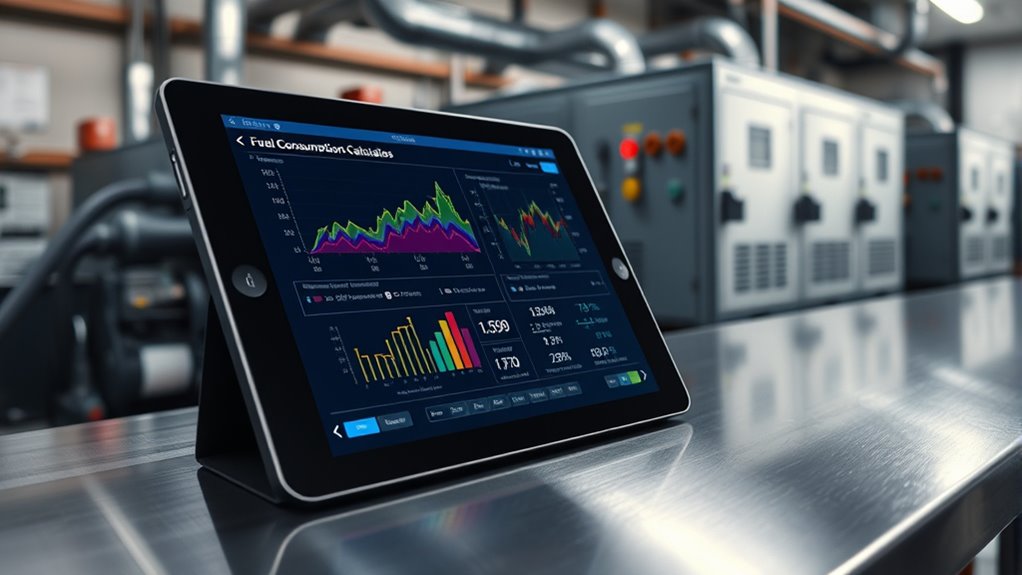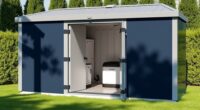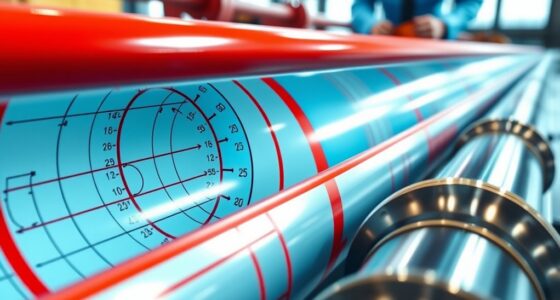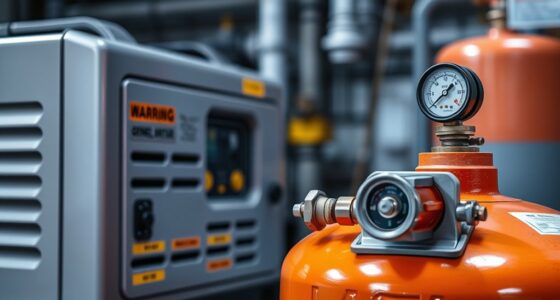To calculate fuel consumption for your standby generator, start by knowing its power output and efficiency, then divide the load by efficiency to find hourly fuel use. Multiply this by the planned runtime to determine total fuel needed. Keep in mind factors like ambient temperature and maintenance, which can affect efficiency. Mastering these calculations helps you avoid shortages and optimize costs—continue further to learn the key factors and practical tips for accurate estimates.
Key Takeaways
- Determine the generator’s power output (kW) and efficiency to calculate hourly fuel consumption accurately.
- Use the formula: Fuel Consumption = (Power Output / Efficiency) × Fuel Energy Content, converting units as needed.
- Multiply hourly fuel consumption by planned runtime to estimate total fuel required for operation.
- Consider fuel costs by multiplying total fuel needed by local fuel price per gallon or liter.
- Regularly monitor actual run time and adjust calculations to optimize fuel use and prevent shortages.
Understanding the Basics of Generator Fuel Consumption

Understanding the basics of generator fuel consumption is essential for managing costs and ensuring reliable backup power. Different fuel types, such as diesel, natural gas, and propane, influence how efficiently your generator runs and how much fuel it uses. Each fuel type has its advantages and environmental impact; for example, natural gas produces fewer emissions compared to diesel. Knowing which fuel your generator uses helps you estimate running costs and plan for fuel availability during emergencies. Fuel consumption depends on the generator’s load and efficiency, so understanding these factors allows you to better manage fuel supplies. Additionally, ventilation considerations are important when operating generators to ensure safety and optimal performance. By grasping these fundamentals, you’ll be better equipped to select the right fuel type for your needs while minimizing environmental impact and controlling costs.
Key Factors Influencing Fuel Usage

Several factors directly influence how much fuel a standby generator consumes during operation. One key element is the fuel type you choose; different fuels, like diesel, propane, or natural gas, have varying energy contents, impacting consumption rates. Additionally, ambient temperature plays a significant role—higher temperatures can cause the generator to work harder to maintain ideal operation, increasing fuel use. Cold weather may also reduce efficiency, making the generator run longer to produce the same power. Other considerations include load demand, maintenance condition, and generator age, but fuel type and ambient temperature are among the most influential. Proper ventilation and airflow can also affect generator efficiency and fuel consumption. By understanding these factors, you can better estimate fuel needs and maximize your standby generator’s performance.
Calculating Fuel Consumption Rate
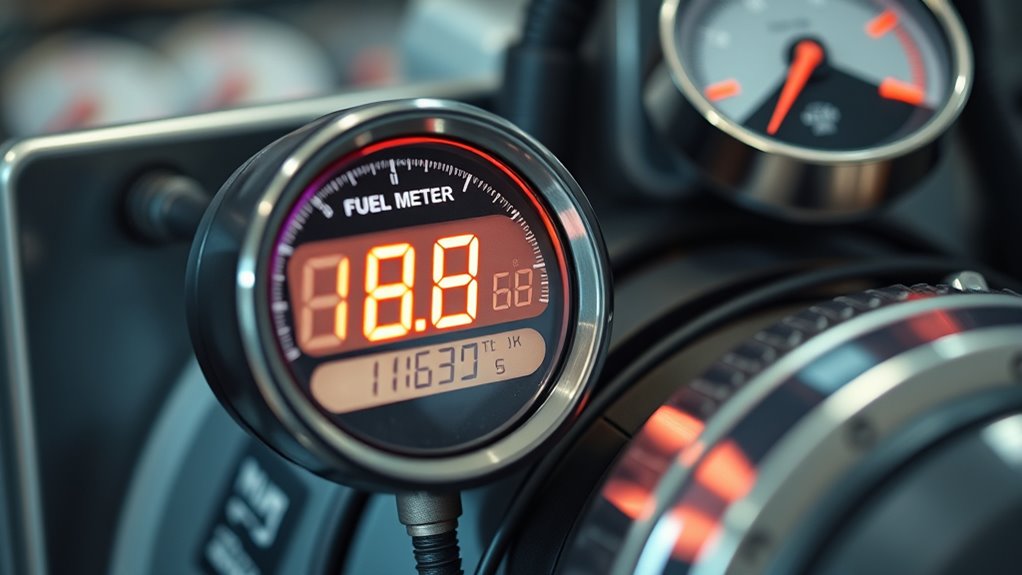
To accurately calculate your standby generator’s fuel consumption rate, you need to know its power output and efficiency. Different fuel types—gasoline, diesel, or propane—affect how much fuel your generator consumes at a given load. You can find this data in the manufacturer’s specifications or operational manuals. Once you have the power output (in kW) and efficiency percentage, you can determine fuel consumption by dividing the power output by the generator’s efficiency, then converting that to gallons or liters per hour based on fuel type. Keep in mind, the choice of fuel impacts environmental impact, with cleaner options reducing emissions. Understanding this calculation helps optimize operation, minimize fuel costs, and lessen environmental harm. Additionally, using appropriate spray tips and proper maintenance can improve fuel efficiency and performance in certain equipment.
Estimating Total Fuel Needed for Runtime
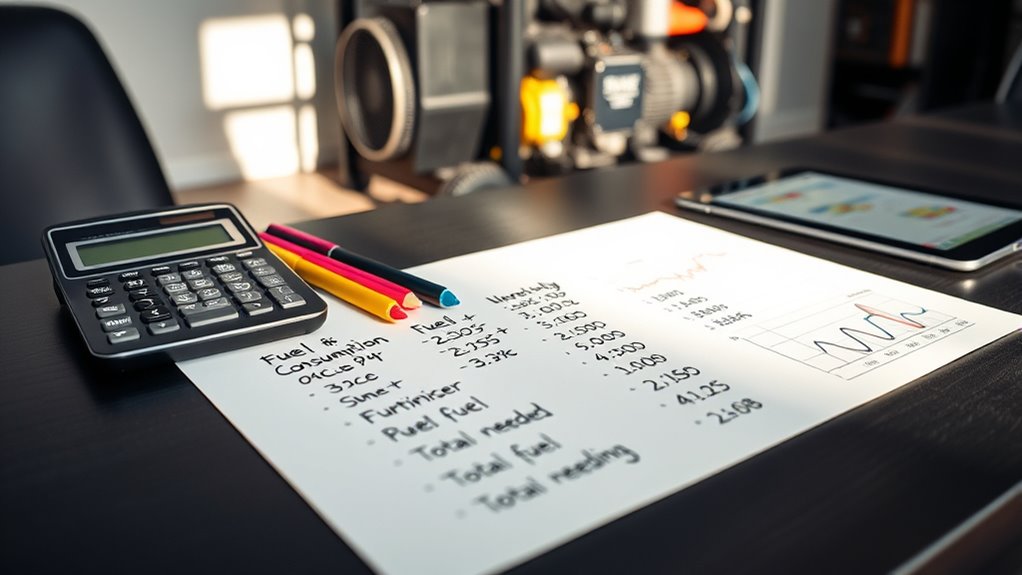
Estimating the total fuel needed for your standby generator’s runtime involves multiplying its hourly fuel consumption rate by the planned duration of operation. This calculation helps determine if your fuel tank capacity can support your needs. Consider your fuel type selection, as different fuels may impact consumption rates. Use the table below to streamline your planning:
| Fuel Consumption Rate (gallons/hour) | Runtime (hours) |
|---|---|
| 0.75 | 4 |
| 1.2 | 6 |
| 1.5 | 8 |
| 2.0 | 10 |
Total fuel needed = consumption rate × runtime. Make sure your fuel tank capacity surpasses this amount to avoid interruptions during power outages.
Practical Examples of Fuel Calculation

Understanding how to calculate fuel requirements in real-world situations helps guarantee your standby generator runs smoothly when needed. For example, if your generator consumes 0.75 gallons per hour and you need 8 hours of backup, you’ll require 6 gallons of fuel. Conducting a fuel cost analysis involves multiplying the total gallons needed by the fuel price per gallon to estimate expenses accurately. When selecting a fuel type, consider factors like availability, cost, and storage safety—diesel might be cheaper but requires more space, while propane offers cleaner burning and easier storage. Additionally, evaluating the total-cost clarity of different fuel options ensures you make informed decisions that align with your budget and operational needs. These practical calculations help you budget effectively and choose the best fuel type for your needs, ensuring your generator remains reliable during power outages without unexpected costs or shortages.
Tips for Optimizing Fuel Efficiency

To get the most out of your generator’s fuel, focus on regular maintenance checks to keep it running efficiently. Managing load properly ensures you’re not wasting fuel on unnecessary power, while setting ideal operating hours prevents overuse. Implementing these strategies helps you save fuel and extend your generator’s lifespan. Additionally, choosing the right environmentally friendly practices when camping can help minimize your ecological footprint and contribute to the sustainability of natural areas.
Regular Maintenance Checks
Regular maintenance checks are essential for ensuring your standby generator runs efficiently and consumes the right amount of fuel. Regularly inspect and replace the fuel filter to prevent clogging, which can cause fuel wastage. Check oil levels to maintain proper engine lubrication, improving performance and fuel efficiency. Keep your generator clean and free of debris to avoid strain on components. Incorporating AI-powered diagnostics can help identify potential issues early, further optimizing fuel consumption.
| Maintenance Task | Frequency | Impact |
|---|---|---|
| Inspect fuel filter | Every 3-6 months | Ensures smooth fuel flow |
| Check oil levels | Monthly | Prevents engine damage |
| Clean air filters | Every 6 months | Improves combustion efficiency |
Staying proactive with these checks minimizes fuel consumption and extends your generator’s lifespan.
Load Management Strategies
Effective load management is key to maximizing your standby generator’s fuel efficiency. By focusing on load balancing, you ensure your generator operates at its most efficient capacity, reducing fuel wastage. Avoid overloading or underloading, which can lead to increased fuel consumption and unnecessary wear. Prioritize fuel use for critical loads, practicing fuel prioritization to ensure essential systems stay powered during outages. Distributing the load evenly prevents strain on the generator, maintaining efficiency over time. Consider shutting down non-essential equipment during power surges to prevent unnecessary fuel use. Regularly reviewing your load profile helps identify opportunities for better load balancing, ensuring your generator runs smoothly without excess fuel expenditure. Incorporating vibrational energy awareness can also help optimize your generator’s performance by aligning operations with energy-efficient practices. Effective load management ultimately prolongs your generator’s lifespan and minimizes operational costs.
Optimal Operating Hours
Optimizing your generator’s operating hours can considerably boost fuel efficiency by preventing unnecessary run time. To do this, monitor how long your generator runs during outages or testing, and adjust schedules to minimize idle periods. Avoid running your generator longer than needed, as extended operation consumes more fuel and increases wear. Establish a regular maintenance schedule to keep your generator running efficiently; well-maintained units consume less fuel and are less prone to breakdowns. Consider scheduling tests during times when power demand is low, reducing unnecessary fuel use. By carefully managing operating hours and sticking to maintenance routines, you maximize fuel efficiency, reduce costs, and extend your generator’s lifespan. Proper timing and upkeep are key to *superior* performance.
Frequently Asked Questions
How Often Should I Check My Generator’s Fuel Levels?
You should check your generator’s fuel levels at least weekly to guarantee reliable operation. During these checks, calibrate your fuel gauge if needed and perform fuel quality testing to spot contamination or degradation. Regular inspections help you catch issues early, preventing downtime. If your generator runs frequently or is critical, consider daily checks. Accurate fuel gauge calibration and testing keep your standby generator ready when you need it most.
What Type of Fuel Is Best for Standby Generators?
You should use diesel or propane, depending on your generator’s design. Proper fuel storage is vital to prevent degradation, especially for long-term use. Consider adding fuel additives to improve stability and prevent microbial growth. Regularly check your fuel quality and storage conditions, and follow manufacturer recommendations. Keeping fuel fresh and treated ensures reliable performance during power outages, minimizing maintenance and repair costs.
Can Weather Conditions Affect Fuel Consumption Rates?
Weather woes can wildly influence your generator’s fuel efficiency. When the weather worsens—with wind, heat, or cold—your generator works harder, consuming more fuel. Harsh conditions hinder performance, causing increased fuel impact and higher costs. You’ll want to monitor weather impacts carefully, ensuring your standby generator stays prepared without wasting fuel. Staying proactive helps maintain ideal operation, preventing unnecessary expenses and ensuring reliable power during any weather event.
How Does Altitude Impact Generator Fuel Efficiency?
Altitude effects can reduce your generator’s fuel efficiency because thinner air at higher elevations causes it to work harder. To maintain peak performance, you should make efficiency adjustments, such as recalibrating fuel consumption rates or upgrading components designed for high-altitude operation. By understanding how altitude impacts your generator, you can better plan fuel needs and ensure reliable power, especially in mountainous or elevated regions.
Are There Maintenance Tips to Reduce Fuel Consumption?
They say “an ounce of prevention is worth a pound of cure,” and that applies to generator maintenance. Regularly check and replace air filters, keep fuel additives in mind to prevent fuel degradation, and guarantee proper fuel storage to avoid contamination. Consistent maintenance keeps your generator running efficiently, reducing fuel consumption and extending its lifespan. Stay proactive, and you’ll save money and ensure reliable power when you need it most.
Conclusion
Understanding how to accurately calculate your standby generator’s fuel consumption can save you money and ensure reliable power. Did you know that proper fuel management can boost efficiency by up to 15%? By applying these calculations, you’ll better predict your fuel needs and avoid unexpected shortages. Keep these tips in mind, and you’ll maximize your generator’s performance while reducing costs. Staying informed empowers you to make smarter decisions—because in power management, precision truly matters.
